Graduating Students’ Exhibition
June 12 – June 29, 2023
The FOFA Gallery and VAV Gallery are pleased to co-present a dynamic collection of works as part of Concordia University’s Faculty of Fine Arts Graduating Students Exhibition. The exhibition moves through both the VAV and FOFA spaces and is shaped to reflect the strength and diversity of practices at the undergraduate and graduate levels.
FEATURED ARTISTS
FOFA
VAV
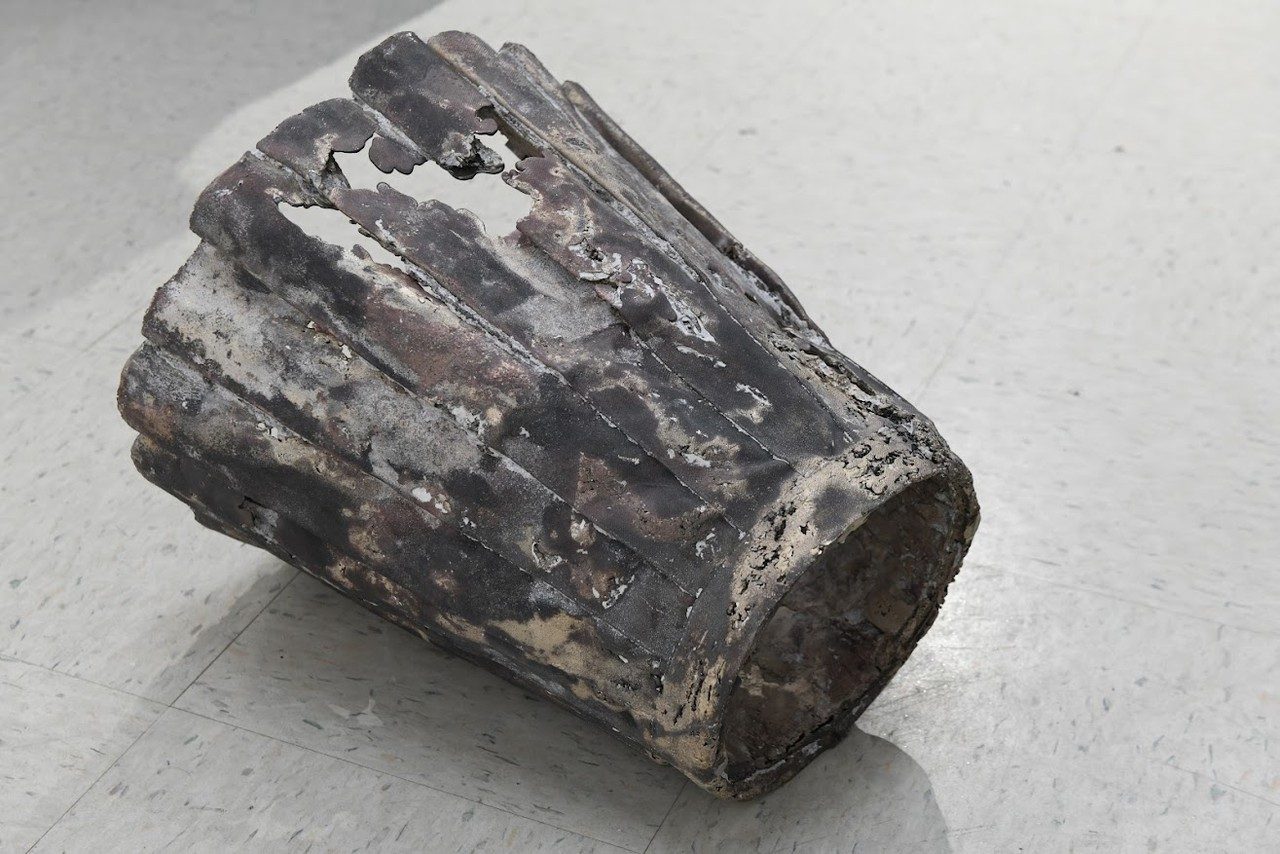
Courtesy of the artist
Bio
Hannah Berger is a multidisciplinary artist whose work considers contemporary visual culture and womanhood through historical methods of making. In the interpretation of issues of sex and power through monumental materials such as bronze, her work establishes a complex relationship with the canon of art history, both drawing from and challenging its visual language. She is based in the unceded territory of Tiohti:àke/Mooniyang and is graduating from Concordia University’s Art History and Studio Arts undergraduate program.
Statement
The tennis skirt is a symbol for youthful femininity that was shortened and tightened by fashion brand American Apparel. Now that it has been excavated (or pried off its plinth,) we can see that it’s still here and will not disintegrate in our lifetime. Where are we to put it?
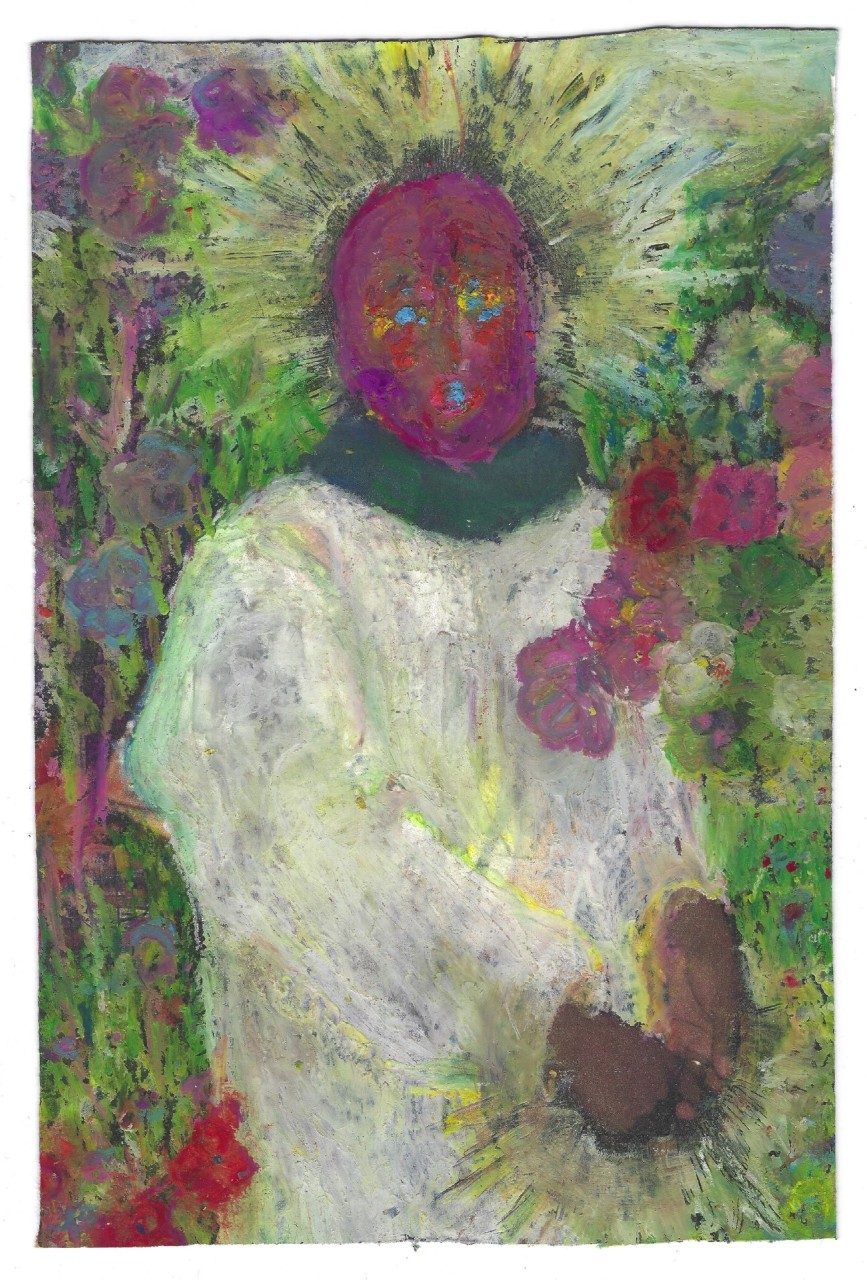
Courtesy of the artist
Bio
Born in Libreville, Gabon, David Bipolo (full name: David Osé Bipolo Demba) moved from his birthplace to Quebec City, Canada at age five. Currently residing in Greater Montreal for his BFA in Studio Art at Concordia University, Bipolo is exploring different media and techniques to open multiple dialogues with the process, the viewers and himself. The experience of immigration, the closeness with family, the sensibility of values and the observation of his surroundings are points of research that resurge in Bipolo’s work.
Statement
Des souvenirs is a project that I'm still trying to apprehend. In it, I explore the notion of memory and a connection with someone, someplace.
As a starting point, I used pictures of myself and my family, and then I drew masked figures and placed them in a situation that converges with photography. Hiding those identities is a choice that was made intentionally. Des souvenirs are not about the point of view of oneself but the retracing of something familiar.
These drawings are sensors of emotions. They are the cause of a real change of trajectory; a visual separation in the explored motif, but mostly emotional. I continue to want to understand this abstruse push.
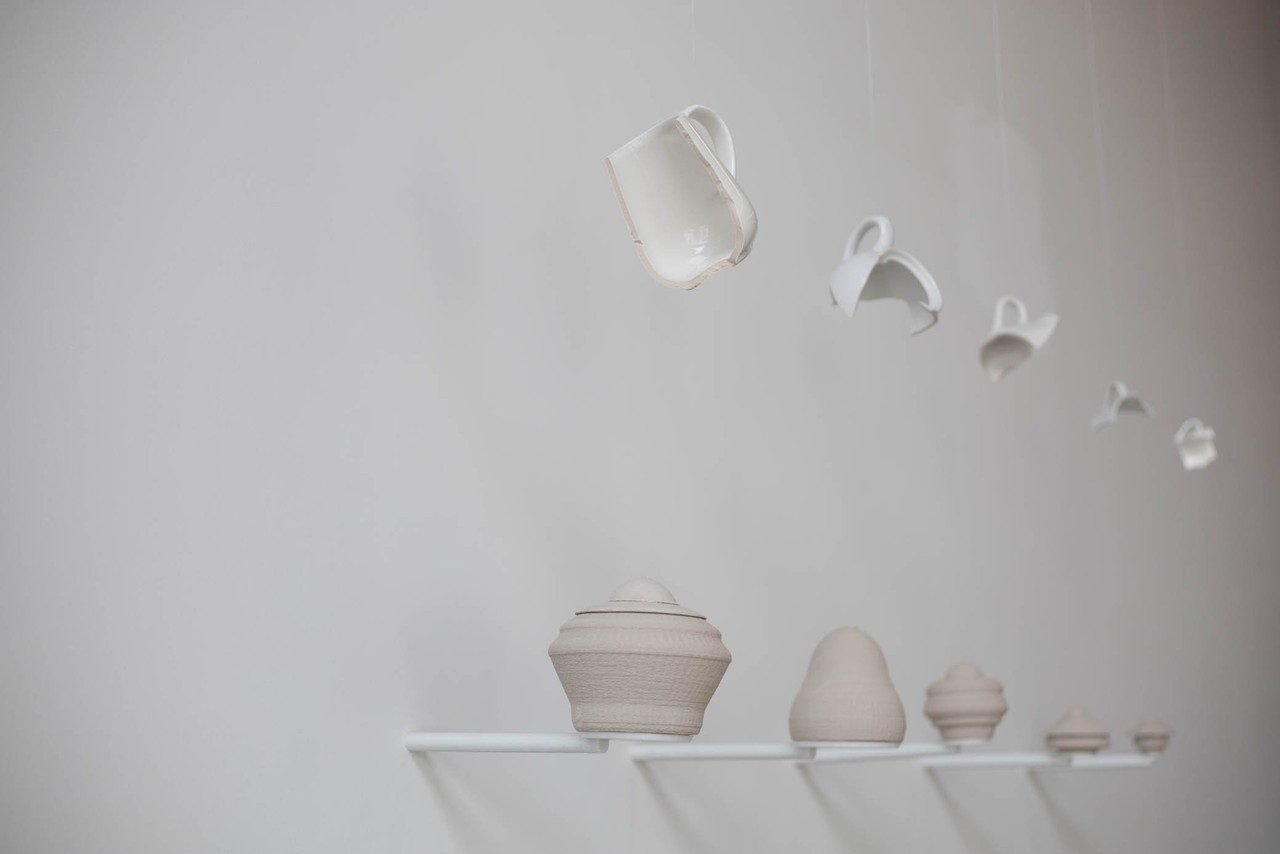
Photo credit: Guillaume Knobloch
Bio
Nick Everett, an artist and composer in Tiohtiá:ke/Mooniyang/Montréal, works with found objects and builds machines. He recently graduated from Concordia University. Nick invents systems for meaningful expression.
Statement
Vessels’ invites the viewer to consider healing, resilience, and rebirth. Broken pots and cups spin in the air, their motion a dance of reconstruction. Life's fractures provide creative constraints and give way to beauty.
Computation transforms the spinning objects, creating new forms through 3D printing. The vessels honor their past and celebrate renewal. Vessels’ reminds us that in vulnerability lies strength, and that we can reshape our stories. It urges us to confront our lives, embracing the power of transformation within us.
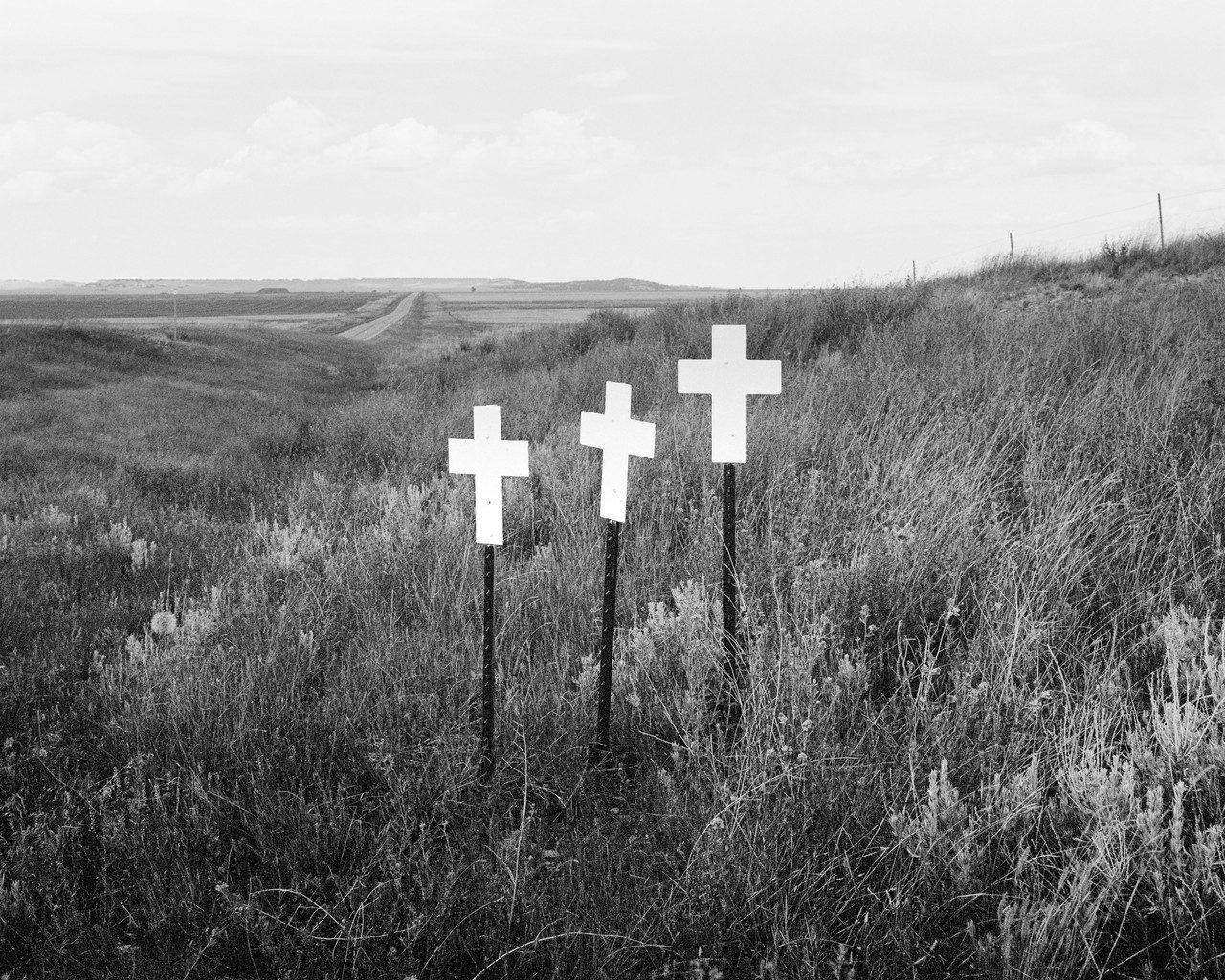
Courtesy of the artist
Bio
Chris M. Forsyth is a visual artist working throughout the United States and Canada whose research-based practice in photography and bookmaking explores the complex and overlapping relationships we have with place. In projects linking themes of history and human geography, he approaches landscape as a layered archive. His work revolves around the varied ways in which we have come to define and redefine our surroundings – ranging from the monumental to the personal. Chris completed his BFA in Photography at Concordia University in 2023.
Statement
Montana Road Wreck examines two overlapping phenomena: the state’s thousands of identical roadside crosses, and its history as a place of limitless speed.
Beginning in 1953, in response to a particularly deadly Labor Day weekend the summer before, the American Legion post in Missoula began a ritual: marking the site of every fatal road accident with an identical white cross. The simple act sought to curb the state’s remarkably high rate of road fatalities by making death ever-present in the cultural memory, folding the living, the dead, and the land into one.
Photographs of fatality markers and intertwined newspaper excerpts present two partial and intersecting narratives loosely reconstructing a history of Montana’s identity as one of the last great outposts of the American West. A place where self-righteous freedom-fighters, free from speed limits, keep the heavy hand of government at bay. And a place where legend and reality become indistinguishable.
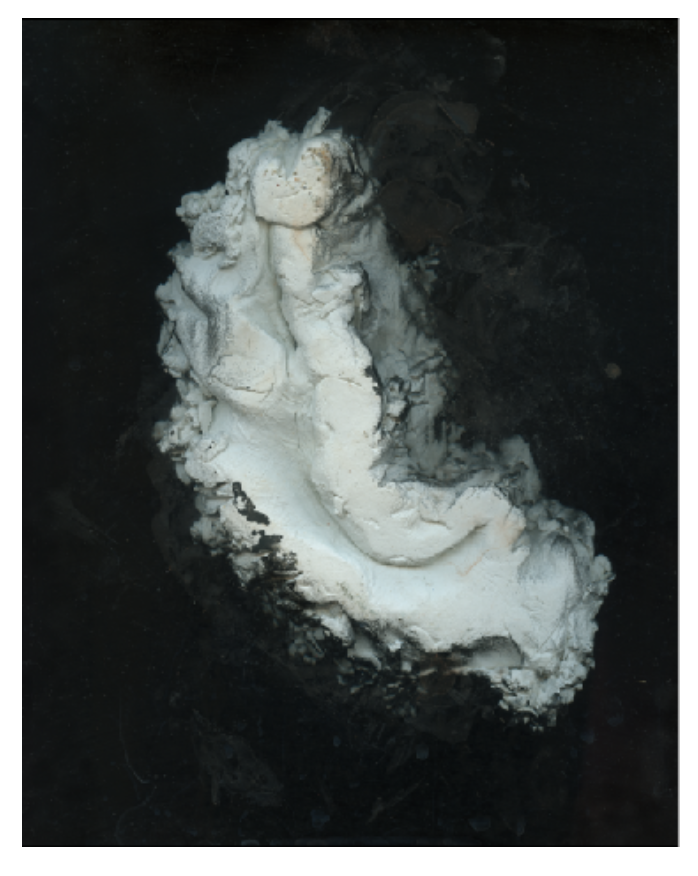
Bio
Gosselin is a recent MFA graduate from Concordia University, and her work has been shown in numerous national and international exhibitions and is part of private collections in Canada and Belgium. Since 2009, she has received support from the Conseil des arts et des lettres du Québec, the Canada Council for the Arts, the Manitoba Arts Council as well as merit scholarships from several foundations. Recently, her video Il faudra en revenir was exhibited at the artist-run centre Vaste et Vague (2022), her series True Stories (géologie de la mélancolie) at artist-run centre Skol (2018), and the series Espaces périphériques at Centre VU (2017).
She has published several books combining text and photographs, including Entre Havre-de-paix et L’Avenir, Rawnessness, and Stay in touch, all available at the BAnQ. Finally, her work can also be seen in Maureen party mix méli-mélo (OK Stamp Press release, 2023), the journals published by IndeKeuken (Belgium), YYY3 (Finland), as well as in Ciel variable (CV108, Quebec).
Statement
La vallée des aurores (The Valley of Dawns) consists of about twelve photographs and two projections, a selection of which are shown here. The project stands as an anthropocosmic fresco depicting our relationship to space, both proper and figurative, the intangible and the transformation of matter by matter. In the photographs, we can sometimes distinguish familiar elements (papaya seeds, organs of domesticated animals), as well as traces, movements, presences, prints, blood and minerals. The sculptures that appear in the photographs were fashioned with non-destructive concerns around eco-anxiety, from the privacy of my living space.
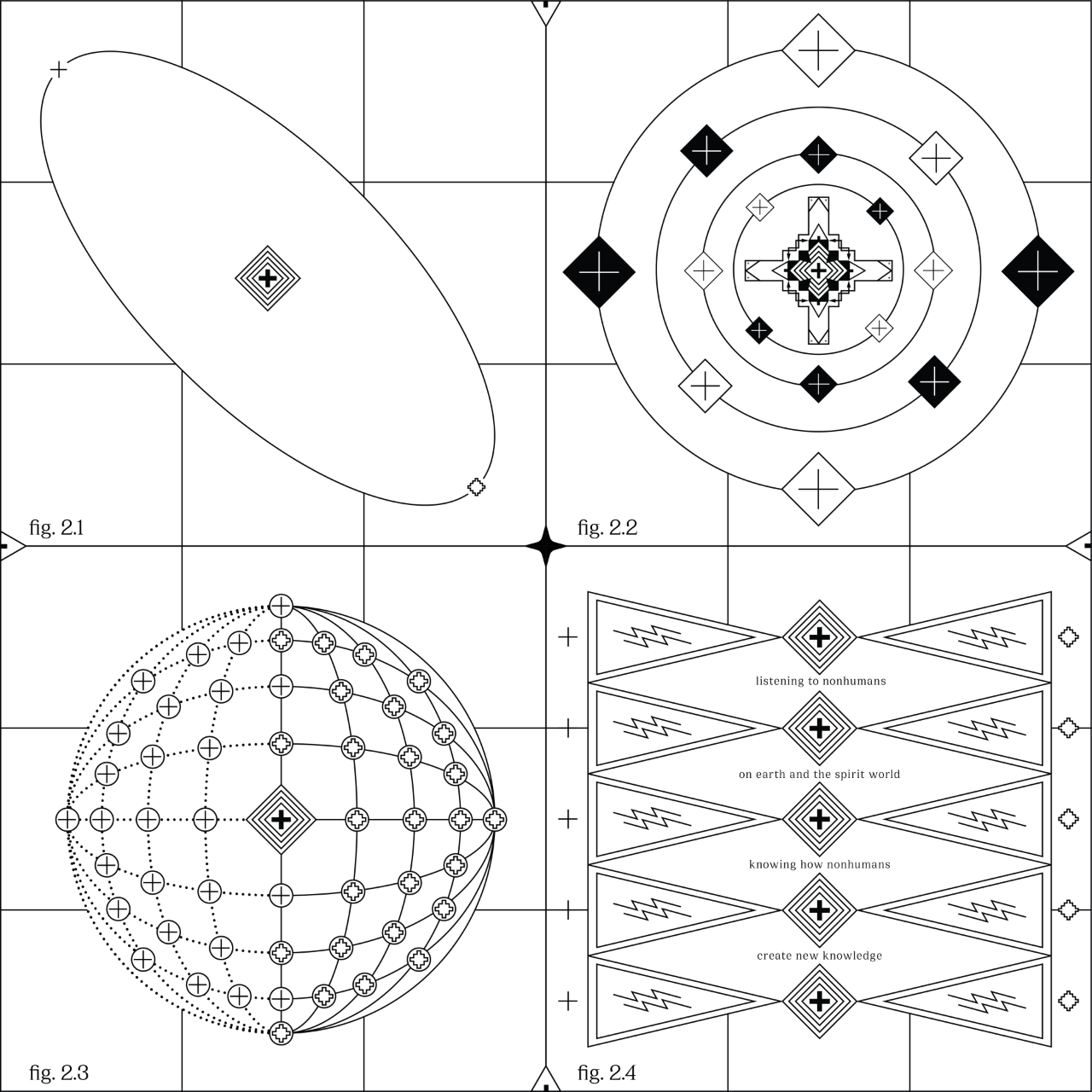
Courtesy of the artist
Bio
Kite aka Dr. Suzanne Kite is an Oglála Lakȟóta performance artist, visual artist, and composer raised in Southern California, with a BFA from CalArts in music composition, and an MFA from Bard College’s Milton Avery Graduate School. Kite’s scholarship and practice investigate contemporary Lakȟóta ontologies through research-creation, computational media, and performance, often working in collaboration with family and community members. Recently, Kite has been developing body interfaces for machine learning driven performance, sculptures generated by dreams, and experimental sound and video work.
Statement
In Lakȟóta ontologies, materials such as metals, rocks, and minerals are capable of both volition and kinship with human beings. From this perspective, Kite creates new spaces for encounters with artificial intelligence, forming innovative methodologies for approaching human and nonhuman relations in a Good Way (an ethical way). This approach calls for a rethinking of the ontological status of each element that composes and creates artificial intelligence, from the earth’s resources mined for technology to the artworks that eventually use them. By bringing Indigenous epistemologies to bear on questions of AI, Kite’s work as a scholar and an artist develops conceptual frameworks and protocols by which we can conceive of expanded relationships with nonhuman computational technology and AI and make room for them in our collective future.
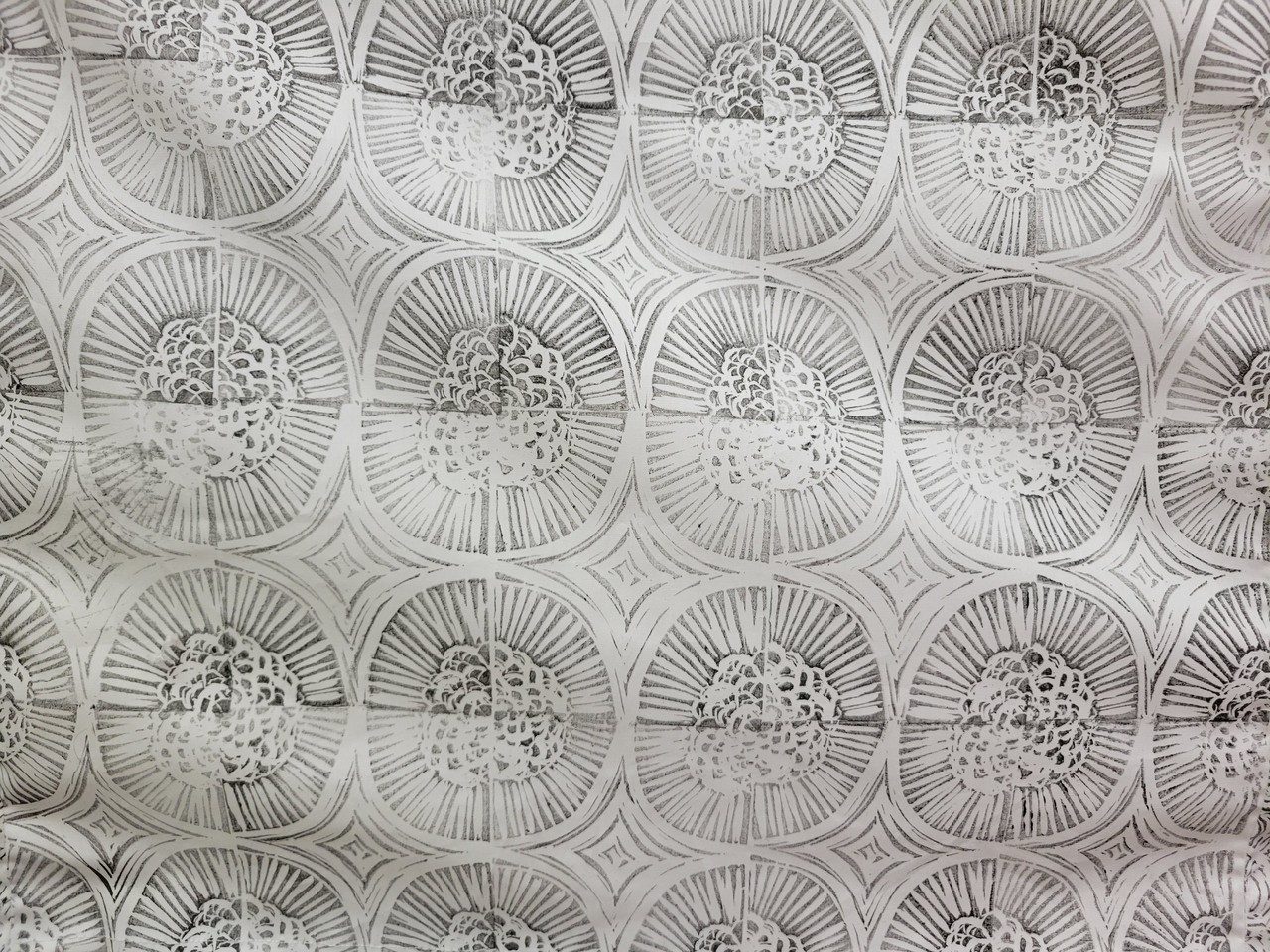
Courtesy of the artist
Bio
Montreal born and raised, Penelope L’Ecuyer graduated with a BFA in Art History in 2020. She recently completed a second BFA in the Art Education Specialization.
Statement
This print was completed using rubber blocks that were carved over time, to progressively reduce the surface of the block. Three blocks of different sizes were used to create three distinct patterns that were sewn together into panels. The top portion of the work is the full block, and as you descend, the block reduces, leaving less and less ink on the fabric. The work is a manifestation of time and effort in my art-making process. I was never someone who liked to make art that was figurative or representative, instead I focus on quantity and processes of repetition to show the amount of time and labour that goes into my work.
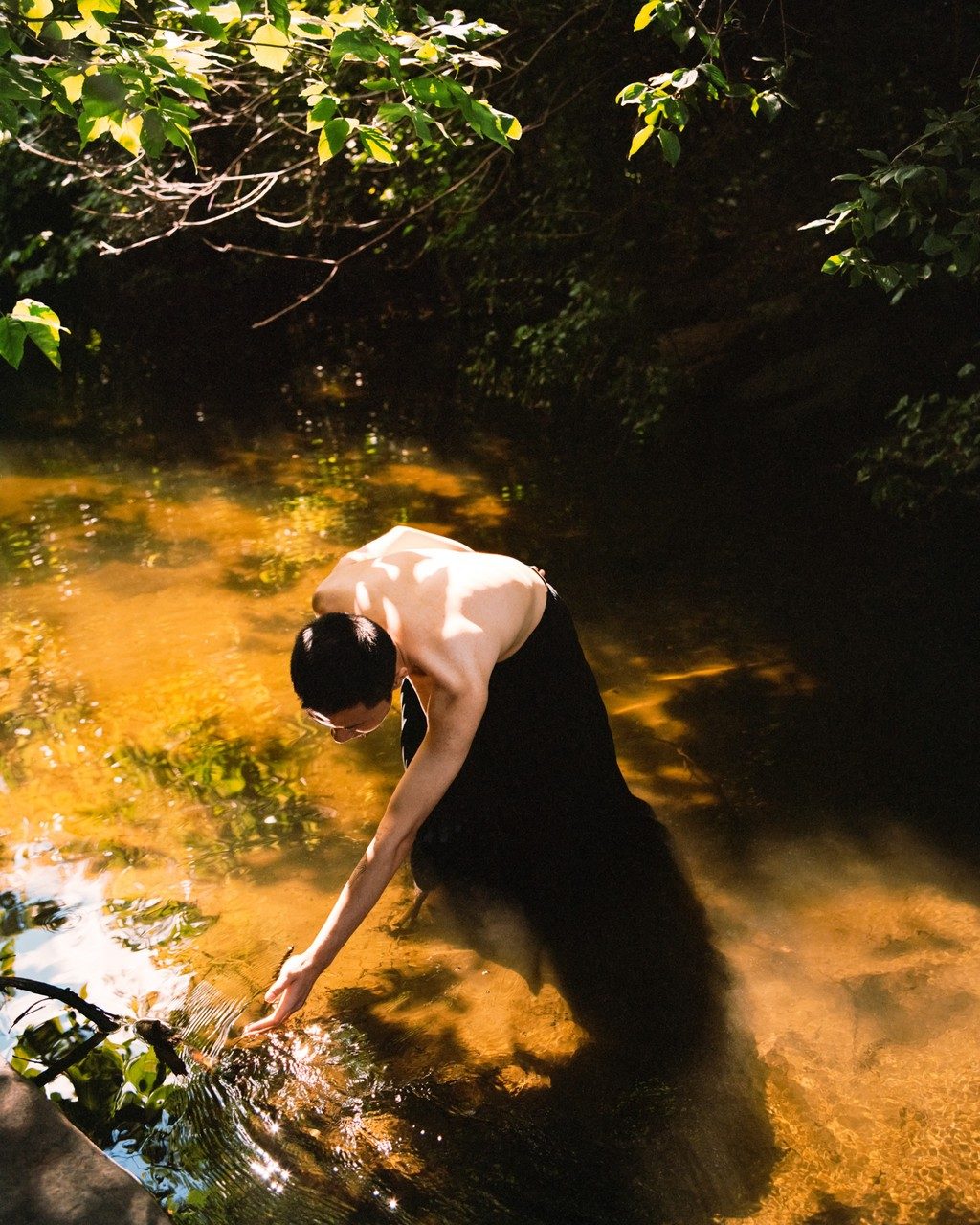
Courtesy of the artist
Bio
Quang Hai Nguyen is a Vietnamese photographer born and based in Tiohtia´:ke/Mooniyang/ Montreal who explores the notion of home and grief within diasporic communities. Through the contemplation of everyday life and the people that surround them, photography is a tool for introspection, a mirror that reflects the ephemerality and loneliness of our being while also revealing universal feelings. They obtained a college diploma in photography at Cégep du Vieux Montréal and recently completed their BFA at Concordia University.
Statement
in these eyes lie an endless ocean navigates between the emotional struggle of isolation and uncertainty shared amongst diasporic Vietnamese communities. To grasp a sense of belonging in a cultural heritage that has historically been known for its past traumatic events, this intimate series of photographs explores how Vietnam’s cultural identity has not truly been grounded yet, but instead, still constantly flows.
As this community gradually spans the globe, we witness a new generation of Vietnamese youth who inherit the stories from the past without ever living through these tragedies. It creates an invisible emotional barrier between intergenerational families and a feeling of alienation in our cultural identity. By isolating each personal experience into a singular visual narrative, this project allows a space that bridges the gap between Vietnamese ancestors and descendants, traces together the untold stories throughout our intertwined historical lineage and attempts to reimagine a future that breaks free from its post-colonial rhetoric.
Sabrina Sherman
Until the Body No Longer Exists, 2023
Video projection on repurposed fabric, 37 min
Dimensions variable
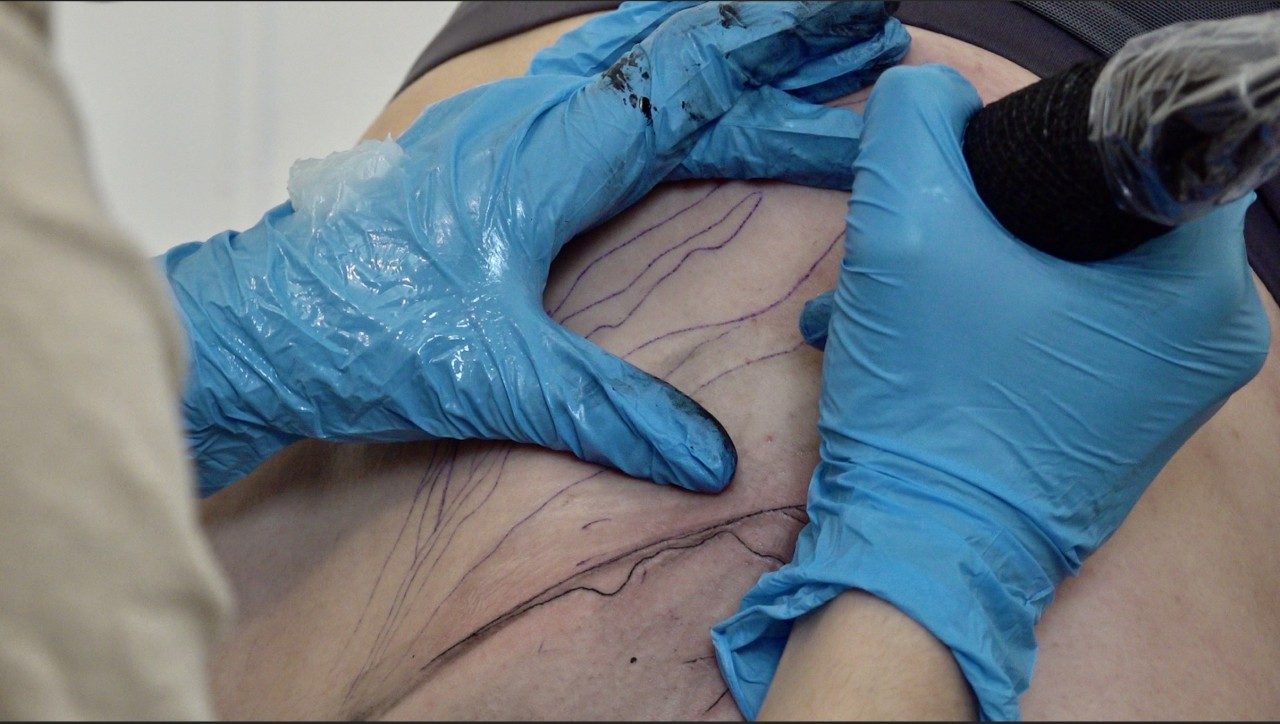
Courtesy of the artist
Bio
Sabrina Sherman is an interdisciplinary artist based in Montreal. They make mixed media installations that explore themes of human relationships and care. They create supportive and comfortable environments that attract the viewer and confront them with complex subjects. In their work, they typically use objects that they interact with daily or items with a previous life, acquired from family or strangers. They are interested in manipulating natural objects and placing them in conversation with human-made ones to question their value. They destroy their materials in order to put them back together and give them a new life.
Statement
Until the Body No Longer Exists explores the relationship between form, memory and bodies through the practice of tattooing. In this video installation, a tattoo holds the memory of a piece of fabric. The work responds to the idea of object permanence and the relationship between body and space. I’ve always struggled to believe that I deserve to take up space. In this work, tattooing creates permanence by marking the body of a friend with imagery that represents the memory of a cloth. This cloth was given to me by a family member and laid on my friend’s body in a temporary moment of care. Fabric only holds a form if it is forced to do so, either through sewing or pinning, but after long enough, the memory of what was there will be present through a wrinkle. Tattoos last until the body no longer exists. I am bringing these two forms together to create a permanent memory of the act of trust between the tattooer and the tattooed, echoing the gesture of care when a cloth is draped on a body.
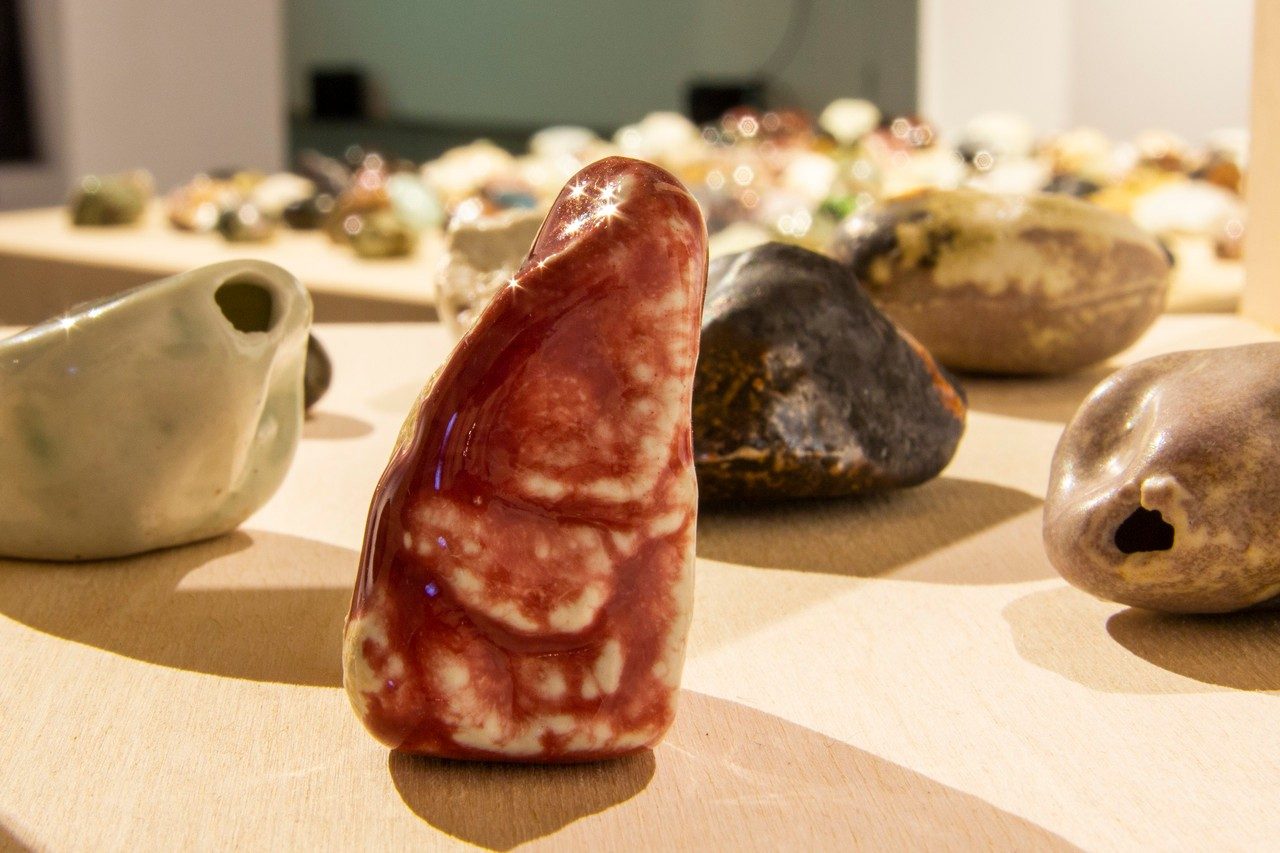
Courtesy of the artist
Bio
Joel Young is a Montréal/Tiohtià:ke/Mooniyang-based artist and cultural worker who makes sculpture and environmental installations. In 2018 he was the recipient of the Emploi Quebec Young Volunteers grant for Vague Magazine, an online publication that explores wearable art and fashion. Since then, his work has appeared in group shows at venues such as Eastern Bloc and Art Mûr. He was the Administrative and Financial Coordinator for the Art Matters Festival 2020 and was a summer resident artist at the VAV gallery in 2021. His work will be part of a show at Espace Loulou in July 2023.
Statement
What Can I Do? is a multimedia installation project that explores material processes, political dialogue and land relations. The work is centered around 300 glazed porcelain sculptures cast from geological debris (ie. rocks) found in the Montreal/Tiohtià:ke/Mooniyang urban area. The size and placement of these objects, their materiality and variegated textures, invite human interaction. They are tactile and beg to be held – when I show them to people, I notice it is a gentle way to start a conversation, to relate to another person through a haptic experience. As an introvert and a crafts person, I believe that the act of making and sharing with others is essential: in doing so we are able to transcend language and discover new ways to relate to one another.
Visitors are invited to sit on the benches and to touch and interact with the ceramic pieces.

